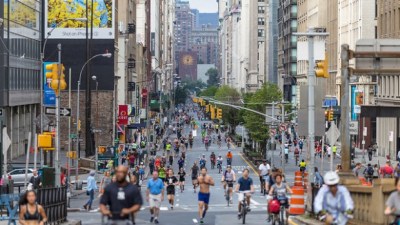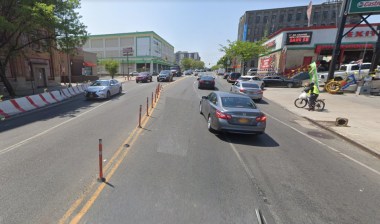Bronx Bummer: Road Deaths are Up in the Boogie Down, Report Shows

Advertisement: Used Dutch Bikes is your one-stop-shop for authentic Dutch bicycles. Choose from classic “grandma bikes” to modern seven-speeds that can haul three kids without breaking a sweat. We carry authentic brands like Gazelle, Batavus, BSP, Burgers, Cortina, and more — available in the USA for the first time!
Road fatalities are soaring this year in the Bronx — the borough that has barely benefitted from the last two mayors’ street safety interventions.
According to a new report from Transportation Alternatives, 28 people were killed on Bronx roads in the first half of 2022, an increase of 22 percent from the 23 people killed last year — and exactly double the number that were killed in 2014 at the dawn of then-Mayor de Blasio’s signature Vision Zero initiative.
In addition, more kids are being killed this year, there are more than double the number of hit-and-run crashes, and the city hit the gruesome 100th death mark earlier this year than in any year since 2014, a portent, perhaps, of even worse things to come.
Those are top line findings of Transportation Alternatives’ Vision Zero quarterly report for the first half of 2022, the group’s latest edition in an ongoing tally.
“New York City remains far from reaching Vision Zero,” Danny Harris, the group’s executive director said in a statement. “More must be done to save lives on our streets — especially in the Bronx.”

Harris called for “bold action to physically redesign streets,” and repitched some of TA’s earlier demands, including setting aside 25 percent of city roads for non-car use (aka the “NYC 25X25” plan); expedite bus lane construction to get from the 3.4 miles built so far this year to the 20 miles that the Adams administration has promised; daylight all corners; set a higher tax rate for heavier cars and trucks to compensate for their greater destructive power; and strengthen the city’s tiny Dangerous Vehicle Abatement Program, which requires the most reckless drivers to take a safety course.
Even as overall fatalities are down from last year — the bloodiest in Vision Zero history — the findings of the six-month report argue for change:
- Road violence killed 112 people (according to TA; the Department of Transportation says 111) on the streets between January and the end of June, an increase of 29 percent (or 27 percent with DOT numbers) over 2018, the safest year on record.
- Fifty pedestrians were killed citywide, which is more than the number killed in the same period in 2020 (37) and 2018 and 2017 (49).
- Twenty-eight people were killed in the Bronx, an increase of 22 percent and double the number killed in 2014. The Bronx is the only borough where fatalities increased from the first half of 2021 to the first half of 2022, TA said.
- Hit-and-runs involving critical injury more than doubled, up 129 percent, in the second quarter of 2022 compared to the same period in 2019. Hit-and-runs are down from last year, but are still up 50 percent year-to-date over 2019.
- For the first six months of 2022, 12 road death victims (11 percent of the total) were aged 18 or under.
- The 100th death of the year came on June 5. During the Vision Zero era, that grim marker has come as late as mid-July.
It’s not like the report didn’t have some good news:
- As bad as this year has been, the 112 people who were killed is far less than the 121 who were killed in the first six months of last year, which went on to be the bloodiest year of Vision Zero.
- Even though 50 pedestrian deaths is a lot in six months, the number is down 21 percent from last year.
- And though this was not in the report, the city’s speed cameras begin operating 24 hours a day, seven days a week on Aug. 1. Earlier this year, DOT said that 31 percent of all on-street traffic fatalities took place in areas that had cameras, but at times when they were not legally permitted to operate. In addition, 59 percent of deaths occur on weekends or overnights, also when cameras were not on. DOT believes the bolstered camera program will reduce speeding and crashes.
Left unsaid in any report of fatalities is just how many serious — but non-fatal — crashes happen in New York every single day. According to the NYPD, there were 52,953 reported crashes between Jan. 1 and July 10 this year, or an average of 277 per day.
Of those crashes, 18,863 — or roughly 100 per day — caused injuries, up 4 percent from the same period last year. The NYPD also said that 4,138 pedestrians have been injured so far this year, or roughly 22 people per day. That’s up 24 percent from last year.
Asked about the TA report, the DOT, which is carrying out the Vision Zero initiative, looked at a broader picture and also towards the future, including pointing out that Mayor Adams has committed nearly $1 billion more funding for the street safety effort over the first five years of his mayoralty.
“In the face of a national uptick in traffic violence, we remain steadfast in our commitment to Vision Zero, and that’s why the administration has made historic investments in safer streets,” agency spokesman Vin Barone said. “DOT is focused in delivering projects equitably in underserved communities and is making significant investments in the Bronx, where the DOT is planning miles of new dedicated bus lanes and protected bike lanes to support efficient, sustainable travel options that improve safety for everyone on our streets.”
The agency pointed out that it has lots of projects in the works, including major bike and bus improvements in the Bronx. For example, DOT unveiled last year a plan [PDF] for many miles of painted and protected bike lanes in the center of the borough between W. Kingsbridge Road and E. 168th Street. And this year, it has revealed updates on a long-stalled Fordham Road bus improvement project [PDF], plus others on Gun Hill Road [PDF] and University Avenue [PDF] (which is underway). The agency said there will be a bus project on Tremont Avenue next year.
There are also many promised bike lane projects in the works, timed to the popular and safe scooter pilot that covers much of the East Bronx.

The TA report also called for several safety enhancements that have been covered intensely in the pages of Streetsblog, including strengthening the open streets program and closing school streets to car traffic. Earlier this year, Streetsblog reported that crashes on the Berry Street open street dropped by 80 percent during car-free hours. Another landmark report revealed that streets with schools on them are more dangerous on average than other city streets. During the 8 a.m. hour, when hundreds of thousands of children stream into 1,600 city-run public schools, there are 57 percent more crashes and 25 percent more injuries per mile on streets near schools than on the city’s other streets. This disparity largely disappears on days when schools are closed.
TA followed that by calling for the creation of “School Streets” by “closing streets to car traffic adjacent to every New York City school, making drop-off and pick-up safer, encouraging parents and students to walk, bike, or take public transit to school, creating a bubble of cleaner air outside schools, and giving every school-age child in New York City access to new and safe public space for active play and outdoor learning.”
DOT said in January that it would improve safety at 1,000 interactions this year, but the agency has not provided an update on that. And the agency has confirmed that its Dangerous Vehicle Abatement Program is not nearly as robust as Transportation Alternatives would like. Through July 8, only 345 drivers had taken the required safety course — which is mandated whenever a driver gets 15 camera-issued speeding tickets or five red-light tickets in any 12 month period. Statistics show that thousands of drivers have met that threshold since the law kicked in last year.



